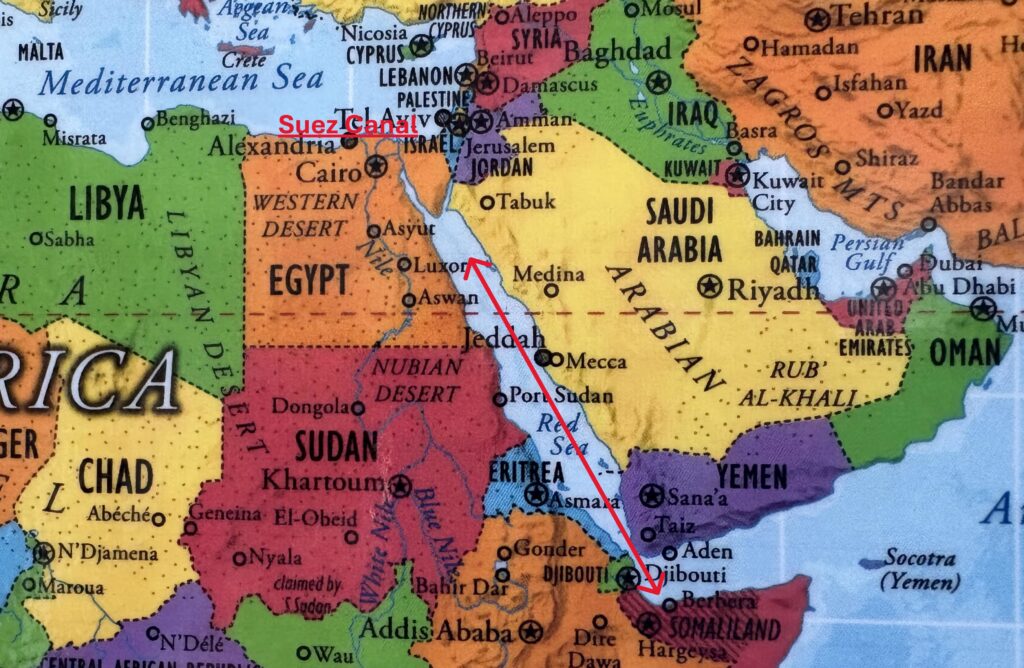#6 The Bab el-Mandeb Strait: Gateway to the Suez Canal and the Wider World

Introduction: The Bab el-Mandeb Strait, the narrow and critical waterway connecting the Red Sea to the Gulf of Aden and the Indian Ocean. It serves as the southern gateway to the Suez Canal, a crucial bridge for trade between European, Asian, and African markets. Previously, the Suez Canal route saw an average of 59 to 75 vessels per day, including significant volumes of oil (around 8.7 million b/d) and LNG. However, recent geopolitical instability has dramatically underscored its vulnerability: overall ship traffic has plummeted by 50% to 66%, with oil flows through Bab el-Mandeb decreasing by over 50%, and LNG tanker transits seeing a near-complete halt, leading to significant rerouting of global shipping.
Geography – A Narrow, Strategic Passage:
- This strait is located between Yemen, on the eastern side of the Red Sea, the Houthi stronghold, to the northeast, and the Horn of Africa, infamous for piracy, to the southwest.
- At its narrowest point, the Bab el-Mandeb is only 18 miles (29 km) wide.
Key Facts & Importance:
- Crucial Suez Canal Link: It’s the only direct maritime access to the Suez Canal from the south, making it indispensable for trade between Europe and Asia.
- Major Global Corridor: In 2023, this Strait facilitated significant global trade, including approximately 8.7 million barrels per day (b/d) of crude oil, and a substantial portion of global liquefied natural gas (LNG), alongside vast amounts of manufactured goods and agricultural products.
- Dramatic Decline & Future Outlook: By the end of 2024, amidst escalating attacks, including the recent sinking of two ships, oil flows through the Bab el-Mandeb had decreased by over 50%, with LNG tanker transits seeing a near-complete halt. With no increases forecast for the future, this route is now at a near complete stop for the flow of energy.
Geopolitical Considerations:
- Houthi Attacks & Maritime Threats: The Bab el-Mandeb, a region long grappling with piracy, has become a perilous hotspot due to ongoing conflict. Since late 2023, Houthi rebels have launched numerous attacks on commercial vessels transiting the Red Sea and the Strait, including the sinking of two vessels in the past week.
- International Response & Rerouting: These attacks have triggered a multi-national military response (e.g., Operation Prosperity Guardian) and led many major shipping companies to reroute vessels around the Cape of Good Hope in Southern Africa, adding 10-15 days and significant costs to voyages.
- Economic Fallout: The rerouting has caused significant delays, skyrocketing shipping and insurance costs (“war zone” premiums), and disrupted global supply chains, highlighting the immediate global economic impact of regional instability. Egypt, heavily reliant on Suez Canal tolls, has seen its revenue from the waterway plunge by billions of dollars, with losses estimated at around $7 billion in 2024.
- Djibouti’s Strategic Role: The small nation of Djibouti, located on the African side of the Strait, hosts multiple international military bases (including U.S., Chinese, French, and Japanese), underscoring the global strategic importance and military focus on maintaining stability in this chokepoint.
Maritime Hazards & Modern Challenges:
- Direct Attacks on Shipping: The primary and most acute hazard is targeted attacks using drones, ballistic missiles, anti-ship missiles, and small armed boats, directly endangering vessels and crews.
- Piracy & Criminal Activity: While overshadowed by recent Houthi attacks, piracy (historically prevalent in the Gulf of Aden) remains a persistent threat, with some forces diverted to counter Houthi actions potentially creating new opportunities for pirates.
- Congestion & Navigation: Despite its strategic importance, the strait’s narrowness, combined with high traffic volume, inherently poses a risk of collisions and accidents.
- Humanitarian & Environmental Risk: The instability and potential for attacks carrying hazardous cargoes (like oil) create a severe risk of environmental disaster and humanitarian crisis in an already fragile region.
